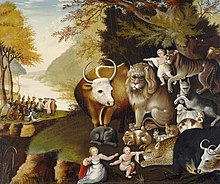The Kingdom of Peace
The Kingdom of Peace ( The Peaceable Kingdom ) are various paintings of the American artist Edward Hicks , based on a Bible passage in Isaiah are based.
painting
In the picture, wolves, lambs and many other animals are common, although they are actually enemies. Edward Hicks always painted against a different background and gave the animals a different place. Sometimes the animals sit on a hill, sometimes in front of a stone bridge, but often an elm can be seen there, which stands for peace. So he painted the picture over a hundred times. His model and inspiration for the pictures was the sentence of Isaiah, one of the most important scriptural prophets of the Hebrew Bible: “Then the wolves will live with the lambs and the panthers will camp with the goats. A little boy will drive calves and young lions and beef cattle together. Cows and bears will graze together so that their young lie together, and lions will eat straw like cattle. And an infant will play at the otter's hole, and a weaned child will stick his hand into the adder's den. ”Almost every picture shows the famous elm under which William Penn signed the Pennsylvania contract of sale with the Indians. With every picture, however, the message is that the wild animals can also be tamed, so that the bad guys also have a good side and that enemies can also live together.
Hicks painted different versions of the painting, 62 of which have survived. Several of the paintings are on display in US museums, including the Worcester Art Museum, the Brooklyn Museum, and the Metropolitan Museum of Art .
Artist
Edward Hicks (1780–1849) lived in a Quaker family. At the age of 13 he began an apprenticeship as a coach maker and at 21 he started his own business as a coach, house and sign painter. From 1812 he worked as a priest and around 1820 he began to paint easel pictures. He ignored the Quakers' critical view of art and viewed his pictures as an illustration of the themes in the service.
Individual evidence
- ↑ The Peaceable Kingdom, 1845-46 , American Art, The Phillips Collection, accessed October 21, 2014.
- ↑ Holland Cotter: Art Review: Finding Endless Conflict Hidden in a Peaceable Kingdom , New York Times, June 16, 2000, accessed October 21, 2014.
- ↑ Edward Hicks: The Peaceable Kingdom , Worcester Art Museum, accessed October 21, 2014.
- ↑ Collections: American Art: The Peaceable Kingdom , Brooklyn Museum, accessed October 21, 2014.
- ↑ Peaceable Kingdom , Metropolitan Museum of Art, accessed October 21, 2014.
- ↑ Edward Hicks' "Kingdom". Die Welt, January 19, 2007, accessed October 21, 2014.
